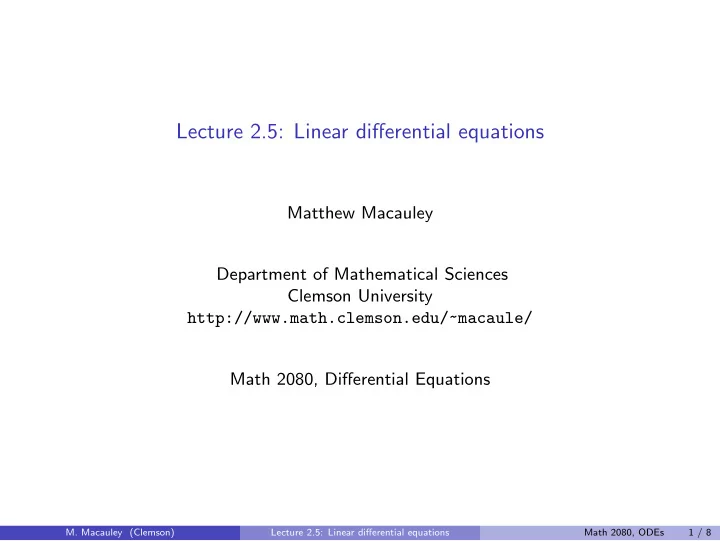

Lecture 2.5: Linear differential equations Matthew Macauley Department of Mathematical Sciences Clemson University http://www.math.clemson.edu/~macaule/ Math 2080, Differential Equations M. Macauley (Clemson) Lecture 2.5: Linear differential equations Math 2080, ODEs 1 / 8
Motivation Recall A first order ODE is linear if it can be written as y ′ ( t ) + a ( t ) y ( t ) = f ( t ) , and moreover, is homogeneous if f ( t ) = 0. Linear differential equations and their solutions have a lot of structure. Understanding the structure helps demystify these objects and reveals their simplicity. We will see two “Big Ideas” in this lecture, and these will re-appear when we study 2nd order ODEs. Along the way, we will uncover a neat short-cut for solving ODEs that is usually not covered in a differential equation course. M. Macauley (Clemson) Lecture 2.5: Linear differential equations Math 2080, ODEs 2 / 8
Big idea #1: homogeneous ODEs Big idea 1 Suppose a homogeneous ODE y ′ + a ( t ) y ( t ) = 0 has solutions y 1 ( t ) and y 2 ( t ). Then C 1 y 1 ( t ) + C 2 y 2 ( t ) is a solution for any constants C 1 and C 2 . M. Macauley (Clemson) Lecture 2.5: Linear differential equations Math 2080, ODEs 3 / 8
Big idea #2: inhomogeneous ODEs Big idea 2 Consider an inhomogeneous ODE y ′ + a ( t ) y ( t ) = f ( t ). If y p ( t ) is any particular solution, and y h ( t ) is the general solution to the related “homogeneous equation”, y ′ + a ( t ) y = 0, then the general solution to the inhomogeneous equation is y ( t ) = y h ( t ) + y p ( t ) . M. Macauley (Clemson) Lecture 2.5: Linear differential equations Math 2080, ODEs 4 / 8
A nice shortcut Applications of y = y h + y p Solving for y h ( t ) is usually easy (separate variables). Sometimes, it’s easy to find some y p ( t ) by inspection. When this happens, we automatically have the general solution! Example 1 Solve T ′ = k (72 − T ). M. Macauley (Clemson) Lecture 2.5: Linear differential equations Math 2080, ODEs 5 / 8
Exploiting our shortcut Example 2 Solve y ′ = 2 y + t . M. Macauley (Clemson) Lecture 2.5: Linear differential equations Math 2080, ODEs 6 / 8
Exploiting our shortcut Example 3 Solve y ′ = 2 y + e 3 t . M. Macauley (Clemson) Lecture 2.5: Linear differential equations Math 2080, ODEs 7 / 8
An interesting observation M. Macauley (Clemson) Lecture 2.5: Linear differential equations Math 2080, ODEs 8 / 8
Recommend
More recommend